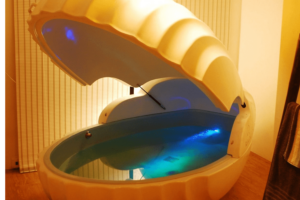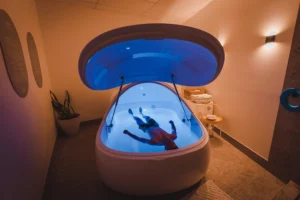In a fast-paced world filled with stress and constant stimulation, finding effective relaxation techniques has become more important than ever. Among the various options available, Float Session Therapy stands out as a unique and scientifically backed method for achieving deep relaxation and mental clarity. But what exactly makes float therapy different from other relaxation techniques, and why does it matter for your health and wellbeing? In this article, we will explore the benefits of float therapy, the science behind float therapy, and how it compares to other methods.
What Is Float Therapy?
Before diving into the differences, it’s essential to understand float therapy. Float therapy, also known as sensory deprivation float therapy, involves lying in a special tank filled with highly salted water at skin temperature. This environment minimizes sensory input by eliminating light, sound, and tactile stimuli, hence the name sensory deprivation float therapy or isolation tank therapy.
During a float therapy session, you float effortlessly, supported by the buoyancy of the water. The unique setup allows your body and mind to enter a profoundly relaxed state, often described as meditative or trance-like.
How Does Float Session Therapy Differ from Other Relaxation Techniques?
Relaxation methods vary widely, from meditation and yoga to massage and deep breathing exercises. Each has its benefits, but float session therapy offers something uniquely powerful:
- Complete Sensory Deprivation
Unlike meditation or yoga, which require some mental focus, or massage which stimulates the body, sensory deprivation float tanks eliminate most external sensory inputs entirely. This allows your brain to rest completely, which is rare in everyday life. - Physical Weightlessness and Muscle Relaxation
The high salt concentration creates buoyancy, allowing the body to float effortlessly. This weightless state reduces muscle tension more effectively than many other techniques, contributing to the float session benefits like pain relief and reduced inflammation. - Enhanced Mental Clarity and Reduced Stress
The absence of distractions helps calm the nervous system deeply. This is why many report significant health benefits of float therapy, including reduced anxiety, better mood, and improved sleep. - Deep Meditation Without Effort
While traditional meditation requires training and focus, the isolation tank naturally induces a meditative state. This is why float therapy for relaxation is often recommended for beginners and seasoned meditators alike.
The Science Behind Float Therapy
Understanding the science behind float therapy helps explain why it works so well. Research shows that floating reduces cortisol (the stress hormone), lowers blood pressure, and decreases muscle tension. The effects of float therapy extend to mental health benefits like decreased anxiety and depression symptoms.
Studies also highlight the benefits of sensory deprivation float tanks in activating the parasympathetic nervous system, the body’s rest-and-digest mode which is crucial for recovery and relaxation.
Top Benefits of Float Therapy You Should Know
When comparing float therapy to other relaxation techniques, the benefits of float therapy stand out clearly:
- Stress Reduction: Floating can significantly reduce stress levels, helping you feel calmer and more balanced.
- Pain Relief: The zero-gravity sensation helps ease chronic pain, including back pain, arthritis, and muscle soreness.
- Improved Sleep: Many people experience better sleep patterns after float sessions due to deep relaxation.
- Enhanced Creativity and Focus: By reducing sensory input, floating helps reset the brain, improving mental clarity.
- Anxiety and Depression Support: There is growing evidence that float therapy for depression and anxiety can improve symptoms by calming the nervous system.
The benefits of floatation tanks are backed by both anecdotal reports and scientific research, making it a valuable tool for holistic wellness.
Why Does It Matter? The Purpose of Sensory Deprivation Tank Use
With so many relaxation options, why should you consider a float therapy session? The answer lies in how float therapy addresses both mind and body simultaneously. Other methods might focus on one or the other, but the purpose of sensory deprivation tank therapy is to promote total-body relaxation.
This total relaxation can lead to profound healing effects, including improved mental health, pain management, and overall wellness. For those suffering from chronic stress or specific conditions like float tank anxiety, float therapy offers a safe, drug-free alternative.
Float Therapy for Specific Conditions
Float tank therapy benefits extend beyond general relaxation:
- Float Therapy for Depression: Floating has been shown to help regulate mood by lowering stress hormones and promoting calmness.
- Float Tank Anxiety: Many users report significant anxiety relief after consistent sessions.
- Muscle and Joint Recovery: Athletes often use float therapy to speed up recovery due to its ability to reduce inflammation and muscle soreness.
What to Expect During Your Float Session Therapy
If you’ve never tried float therapy before, you might wonder what a session feels like. A typical session lasts about 60-90 minutes, during which you lie back in the tank, close the door, and float silently. The absence of sensory input encourages your mind to enter a deeply relaxed state naturally.
Afterward, many people feel refreshed and mentally clear, similar to after a good night’s sleep.
Frequently Asked Questions (FAQs)
Q1: What are the main health benefits of float therapy?
A1: The main benefits include stress relief, pain reduction, improved sleep, enhanced mental clarity, and support for anxiety and depression.
Q2: How often should I do a float therapy session?
A2: Many experts recommend starting with 1-2 sessions per week to experience maximum benefits, but even occasional sessions can be helpful.
Q3: Is float therapy safe for everyone?
A3: Float therapy is generally safe for most people. However, those with certain medical conditions or severe anxiety may want to consult a healthcare provider first.
Q4: What is the difference between float therapy and meditation?
A4: Meditation requires active mental focus, while float therapy induces a meditative state passively by reducing sensory input.
Q5: Can float therapy help with chronic pain?
A5: Yes, many people find relief from chronic pain due to the weightless environment and muscle relaxation.
Q6: What does a float session feel like?
A6: Most describe it as deeply relaxing and peaceful, with a sensation of floating effortlessly in warm water.
Conclusion
What makes float session therapy truly unique compared to other relaxation techniques is its combination of sensory deprivation, weightlessness, and mental calm all scientifically proven to promote healing and relaxation. Whether you’re seeking stress relief, pain management, or mental clarity, float therapy offers powerful benefits worth exploring.
With the growing body of evidence supporting the benefits of float therapy and the enjoyable experience of a float therapy session, it’s clear why this method matters so much for modern wellness.




